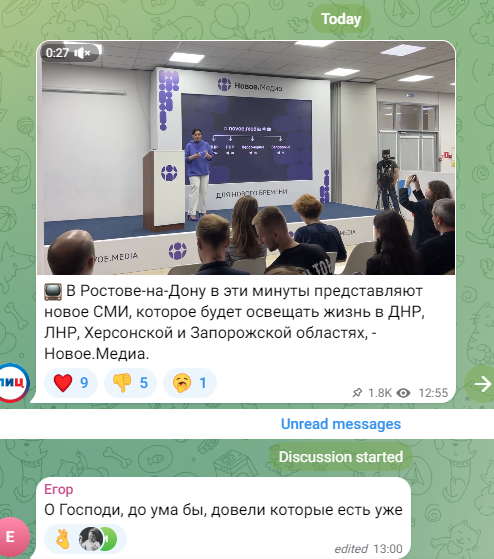What reality is actually portrayed by the “media” in the occupied territories of Ukraine?

A new online media outlet has recently appeared in the temporarily occupied territories of Ukraine, actually branded as “Novoe.Media” (New Media). According to Kremlin propagandists, this online resource is intended to become “the voice of the Donbas and Novorossiya” and help residents of the occupied regions “integrate” into Russia’s new vision of a “large multinational country.”
The staff of this “media” will consist of 40 people, with 25 recruited directly from the local population in the occupied areas.

The concept of this “media” can be clearly understood from the choice of editor-in-chief: Larysa Rzhondovska, a media technologist who runs a Telegram channel with over 100,000 subscribers where she mocks Ukrainians and amplifies Kremlin messages.
“Novoe.Media” is now operational, with sections divided along the lines of the four temporarily occupied Ukrainian regions. The news coverage adheres to a Soviet-style propaganda playbook: roads being built, buildings restored, humanitarian aid and water delivered, children and parents improving their health — all, of course, “under the patronage of government agencies.”
In total, according to the Institute of Mass Information, the russians plan to allocate the equivalent of $5.7 million solely for the media sector in Ukraine’s Kherson Region in 2024. Evidently, russians are attracting considerable funds for the development of propaganda media. The money will be used to construct an alternative information “reality” in the occupied territories.
How it all works
First, the russians create an information blockade: shutting off Ukrainian television and seizing local media outlets. Then, they publish propaganda materials under their own branding. For example, the editorial offices of newspapers like “Mayak” in Beryslav, “Chornomorets” in Skadovsk, “Naddniprianska Pravda” in Kherson, etc. were all seized by the occupiers. Local printing houses in Nova Kakhovka were also captured.
To disseminate their propaganda in Mariupol and Melitopol, the russian occupiers have exploited the authority of local media outlets such as “Pryazovsky Rabochy” and “Melitopolski Vidomosti”. In March 2022, they looted equipment at the Suspilne branch office and set up one of their headquarters on the premises.
On top of all that, the occupiers are also resorting to terror tactics against local journalists who refuse to become complicit propagandists. In April 2024, through the Telegram channel “New Melitopol. Zaporizhzhia Region”, they issued demands for the administrators of the Ukrainian “RIA Melitopol” edition to surrender, calling on them to “go to Victory Square” in the “liberated Melitopol”.
It is also known that the journalist Anastasiya Hlukhovska from this media outlet, along with the Telegram channel’s administrator Heorhiy Levchenko, have been in russian captivity for eight months. In May 2023 in Melitopol, the occupiers also abducted journalist Iryna Levchenko and her husband Oleksandr, whose whereabouts remain unknown. Both of them are retired.
The case of Izium illustrates the modus operandi of most russian propaganda outlets. The main newspaper was the Ukrainian-language “Obriyi Iziumshchyny” (Horizons of Izium Region). When russians captured the city, they looted its newly renovated editorial office, forcing the journalists to flee the city and maintain a website from evacuation. The propagandists then published their own printed “Iziumskiy Telegraf” from the seized premises. In russian, of course.
Now that Izium has been liberated, the “Obriyi” (Horizons) media outlet has resumed publishing. The “editor-in-chief” of the propaganda leaflet has been notified in absentia of suspicion of state treason for voluntary cooperation with the russian occupiers and joining the ranks of their local administration.
Thus, the creation of the “Novoe.Media” outlet shows the massive effort and funds Russia is investing to distort the information landscape in the occupied areas of Ukraine. In the next post, we will analyze the narratives of this landscape, using several print newspapers as examples ![]()
Prepared by Aliona Malichenko.






